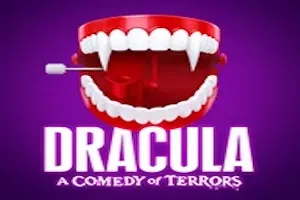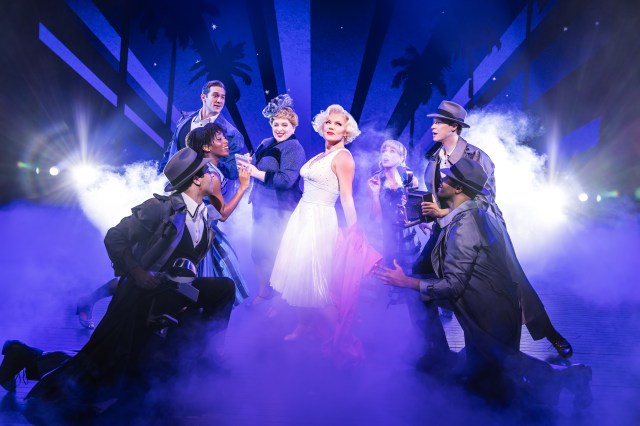Review: Dracula, A Comedy of Terrors Is a Gay Old Time
The new Bram Stoker riff by Gordon Greenberg and Steve Rosen comes to New World Stages.
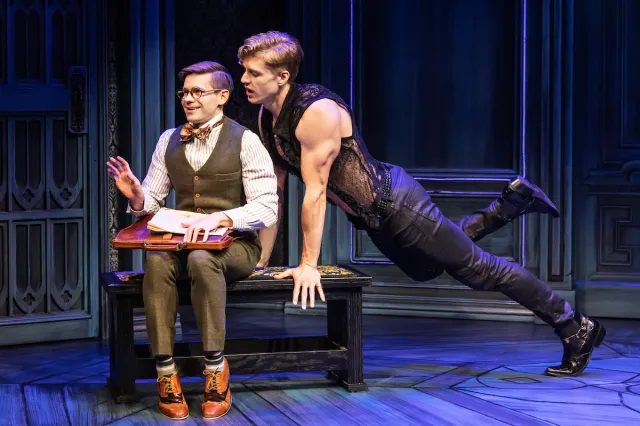
(© Matthew Murphy)
It’s always refreshing when a show knows both its audience and exactly how to play to them. Gordon Greenberg and Steve Rosen’s Dracula: A Comedy of Terrors is calibrated precisely for a mostly gay, Hell’s Kitchen, off-Broadway crowd at New World Stages. In this take on Bram Stoker’s 1897 Gothic horror classic, the comedy is broad, the small cast is often in drag, the jokes are all played with a wink to the audience, and perhaps most importantly, the Count himself is a tall, blonde, muscular hunk in leather pants and occasionally sans shirt. Need I say more?
In some ways, I am the ideal audience member for this play: a gay resident of Hell’s Kitchen who loves camp and happens to be a scholar of Victorian literature. In other ways, I’m perhaps the worst audience member, largely because I know too much about the source material. I found myself occasionally overthinking this bawdy farce, which tends to over-simplify the adaptation itself.
Clearly though, this production is not supposed to be analyzed that intensely. We are just meant to laugh at the endless string of witty jokes and Monty Python-inspired physical gags (all expertly executed) and drool a bit at the beautiful actors. Pushing my dramaturgical gripes aside, there is so much to enjoy here. It is a gay, sexy, campy delight of a Dracula that clocks in at a tight 90 minutes.
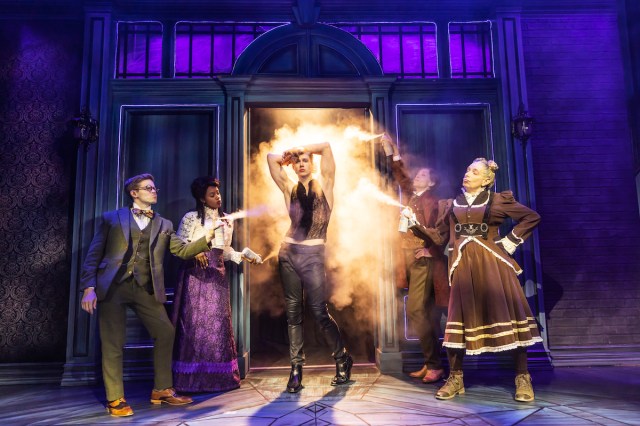
(© Matthew Murphy)
For those unfamiliar, Dracula tells the tale of a Transylvanian vampire who comes to England to find new victims, particularly Jonathan Harker and the women in his life. While some plot points were simplified and several characters were combined or cut to accommodate five actors, several choices confounded me. Why did the playwrights switch the names of Mina and Lucy? Why cut out the famously homoerotic scene at the castle where Dracula seduces Jonathan? What does it mean to take Dracula, a figure frequently read as representing a host of marginalized identities, and make him into a white, conventionally attractive, muscular, blonde sexpot?
The acting is superb and the company works together so well. James Daly, as our sexy Count Dracula, is a sort of Gothic Dolly Levi, and the audience is enraptured every time he is onstage. He is as hilarious as he is handsome. Andrew Keenan-Bolger does great work with meek Jonathan, and his and Daly’s height difference makes for comedy gold. Jordan Boatman as Lucy, Jonathan’s fiancée, has a great take on the classic horror flick heroine, most memorably in an inspired boudoir moment where she effortlessly shimmies her lacey robe off one shoulder as she throws herself against a wall.
Ellen Harvey and Arnie Burton, who round out the company, are sublime. The play uses them and drag to poke fun at traditional Victorian gender politics. Harvey frequently flips between the sexist Dr. Westfeldt and his patient, Renfield, with the panache of a vaudevillian. Burton, meanwhile, plays Mina and a feminist female Dr. Van Helsing; while he perhaps takes his Mina a bit too far (especially in the lisp), his Van Helsing is so funny he steals every scene he’s in.
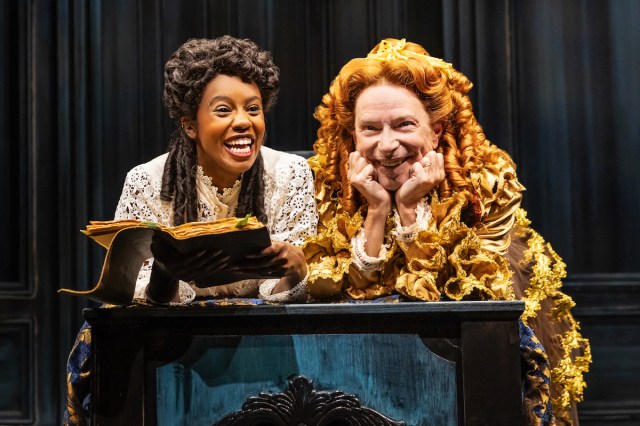
(© Matthew Murphy)
In every joke, in the costumes by Tristan Raines, in the playful usage of drag, and in the very essence of the alluring title figure, this show is heavily leaning into gay camp. That said, they could’ve taken things further: more shirtlessness and more sex! The original text itself is very gay, and an issue contemporary Dracula adaptors have is that they feel the need to update the source material to make it queerer and have more to say about gender. In fact, these themes are at the very core of the novel. For a production that is oh-so-very gay in its aesthetic and humor , the play itself was far too heterosexual.
Though once again, I don’t believe the play is actually trying to say much of anything about sexuality as much as it is just trying to be sexy– and it does that very well. While this may not be the truest or most cerebral adaptation of Dracula, it is certainly the gayest and campiest version I’ve ever seen, and one that I’d like to think Bram Stoker (who is widely believed to have been queer) would’ve enjoyed.


